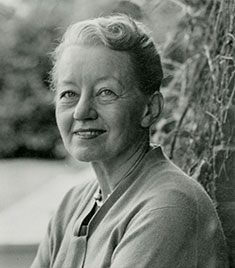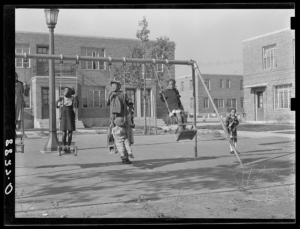
Residential Street, Greendale, WI, 1939
A community planned by the Suburban division of the U.S. Resettlement administration
Photo Credit: Columbia.edu
Homelessness in the U.S. has become so normalized as to be accepted as a fact of life. The National Alliance to End Homelessness reports that more than a half million people are without shelter on any given night. Public officials seem at loss to help the thousands now sleeping in our parks and city streets.
This was not always the case. In his “Second Bill of Rights” speech in 1944, President Franklin Roosevelt declared employment, education, housing and medical care as rights due every citizen— values that underpinned the New Deal and the humane policies they inspired.

Drafting room, Washington D.C., 1936
Architects with U.S. Resettlement Administration design plans for Greenbelt, MD
Photo Credit: Carl. M Mydans, Columbia.edu
Public housing was once thought of as being positive, radical, and hopeful—the product of a government optimistic about its ability to improve the lives of its poor and working-class families. Today, market-based solutions are touted as the answer to society’s problems. Developers may be required to dedicate a few affordable units in exchange for permits for their market-rate housing projects, but this does little to help low-income people. In fact, long-time residents are often displaced by the resulting gentrification.
When millions were displaced by the Dust Bowl and job loss during the Great Depression, the federal government made housing a priority. The Roosevelt Administration enlisted leading thinkers, collectively known as “housers.” These architects, designers and social scientists challenged barriers to housing for all.

Catherine Bauer Wurster (1905-1964)
The foremost housing advocate of her generation and primary author of the landmark U.S. Housing Act of 1937, the nation’s first affordable housing legislation.
Photo Credit: Ced.berkeley.edu
Catherine Bauer was among the most influential, as author of a seminal book on government-supported housing in post-WWI Europe. In “Modern Housing,” Bauer argues for making decent housing a “public utility” and a basic right. Bauer was the primary author of the U.S. Housing Act in 1937 that provided federal subsidies to local public housing agencies to improve living conditions for low-income families. Bauer also worked with the Federal Housing Administration (FHA), which lowered financial barriers to home ownership. She promoted non-speculative housing owned by public agencies or nonprofit cooperatives and was a vocal advocate for racially integrated public housing at a time when Blacks and other minorities were excluded.
In 1933 about half of the nation’s home mortgages were in default. Millions had lost their homes and millions more were in danger of doing so. The Public Works Administration and the Works Progress Administration set about building public housing, while the Resettlement Administration relocated struggling urban and rural families to communities planned by the federal government.
During this time, New Deal legislation brought home ownership into reach for many, creating a bridge to the middle class. The Home Owners’ Loan Act of 1933 helped those in danger of losing their homes. The National Housing Act of 1934 produced the Federal Housing Administration and the Federal Savings and the Loan Insurance Corporation; which raised housing standards and provided a system of mortgage insurance. The Housing Act of 1937 established the U.S. Housing Authority (USHA) to provide loans for low-cost housing projects. The G.I. Bill of 1944 provided low-interest home loans to war veterans.
In 1940, Bauer reported that 193 loan contracts had been approved between USHA and local authorities for 467 different projects to rehouse more than 150,000 families—some 650,000 people—and that 100,000 dwellings had been completed or were under construction.
Other influential “housers “were landscape architect Garrett Eckbo, who worked for both the USHA and the Farm Security Administration (FSA) designing housing for migrant agricultural workers and Vernon DeMars, also with the FSA, who planned and designed affordable housing for thousands of wartime workers.
The “housers” emphasized affordability, quality construction and human-scale design in harmony with the environment. Or, as, Eckbo put it, “What is good for the rich is good for the poor.”
With the US economy crushed by the coronavirus, homelessness is on the rise. The values expressed in FDR’s Second Bill of Rights have been sidelined, along with the social welfare policies they inspired. But, as the New Deal shows us, homelessness can be solved, given the political will to do so.
“Movements are not made by a handful of specialists,” Bauer concludes in “Modern Housing.” Change would come only when Americans “demanded a positive program of good housing—not merely for some vague, hypothetical ‘slum-dwellers,’ but for themselves and their families.”





